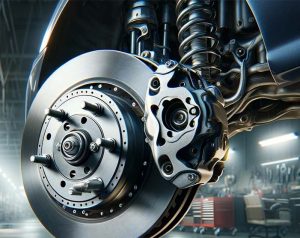Brake rotors are an integral part of a vehicle’s braking system, serving as the contact point for brake pads to slow or stop the vehicle. They come into action when the brake pedal is pressed, causing hydraulic pressure to compress the brake pads against the rotors. Despite performing similar functions, front and back rotors have distinct features and specifications designed to handle varying demands during braking. This piece aims to clear common misconceptions and provide detailed insights into the rotors’ roles.
Every wheel on a car is equipped with a rotor, but not all rotors are created equal. When the driver engages the brake pedal, hydraulic pressure transmits through the brake lines, bringing the pads into contact with the rotors. This friction causes the vehicle to decelerate. Rotors are subject to wear due to the constant heat and pressure from this process, necessitating regular inspection and timely replacement to uphold the braking system’s integrity and performance.
Comparing Front and Back Rotors
Front rotors are designed to take on more responsibility due to the natural dynamics of a moving car. Upon deceleration, a vehicle’s momentum shifts forward, placing a higher demand on the front brakes for effective stopping power. This is why front rotors are typically more substantial in construction compared to rear rotors. They’re not just larger in diameter but also often thicker, enabling them to absorb and dissipate the higher levels of heat produced during braking. Consequently, this design ensures that the front brakes can handle the increased stress without compromising on performance or safety. The rear rotors, while crucial, support the front but are subjected to less strain and therefore can be smaller and lighter.
Significance of Rotor Sizes and Placement
The importance of rotor sizes and their placement in the vehicle cannot be overstated. Here’s a table that summarizes the key points of their significance:
| Feature | Front Rotors | Back Rotors |
| Size | Larger due to higher braking demands | Smaller, complementing front rotors |
| Thickness | Thicker to absorb more heat | Thinner as they deal with less heat |
| Heat Dissipation | High capacity due to greater heat generation | Moderate capacity as they generate less heat |
| Wear Rate | Higher wear due to more stress | Lower wear as they assist in braking |
Front rotors usually handle up to 70% of the braking force due to the vehicle’s dynamics during deceleration, hence their larger and thicker dimensions. The rear rotors, though smaller, play a crucial role in maintaining stability and preventing the vehicle from skidding or fishtailing during braking.
Recognizing the Need for Rotor Replacement

Selecting the Right Rotors for Your Vehicle
Choosing the appropriate brake rotors is essential for vehicle safety and optimal brake performance. Here are some points to consider when selecting rotors:
- Compatibility: Ensure the rotors are compatible with your vehicle’s make and model.
- Type: Choose between ventilated or solid rotors based on your vehicle’s requirements.
- Material: Consider rotors made of cast iron, steel, or composite materials for better performance.
- Driving Conditions: Assess your typical driving conditions (city driving, towing, etc.) to select a rotor that matches your usage.
For owners of heavy-duty trucks such as the F250 Super Duty, identifying the best brake rotors for F250 Super Duty is crucial to handle the additional weight and towing demands.
Conclusion
Delving into the question of whether the front and back rotors are the same, it becomes evident that they are intentionally differentiated. Front rotors typically bear a heavier load due to the dynamics of vehicular motion, necessitating a more robust build to handle the increased braking force and heat. Rear rotors, while similar in function, are tailored to provide vehicular stability and often endure less strain. This structural variation underscores the importance of selecting the correct rotor for each position to maintain the vehicle’s braking efficiency. When it comes to safety, the right choice in rotors is as crucial as any other component in your car. Proper rotor maintenance and timely replacement are not just about upkeep; they’re about preserving the integrity of your vehicle’s braking system, thereby ensuring the safety of each journey.

